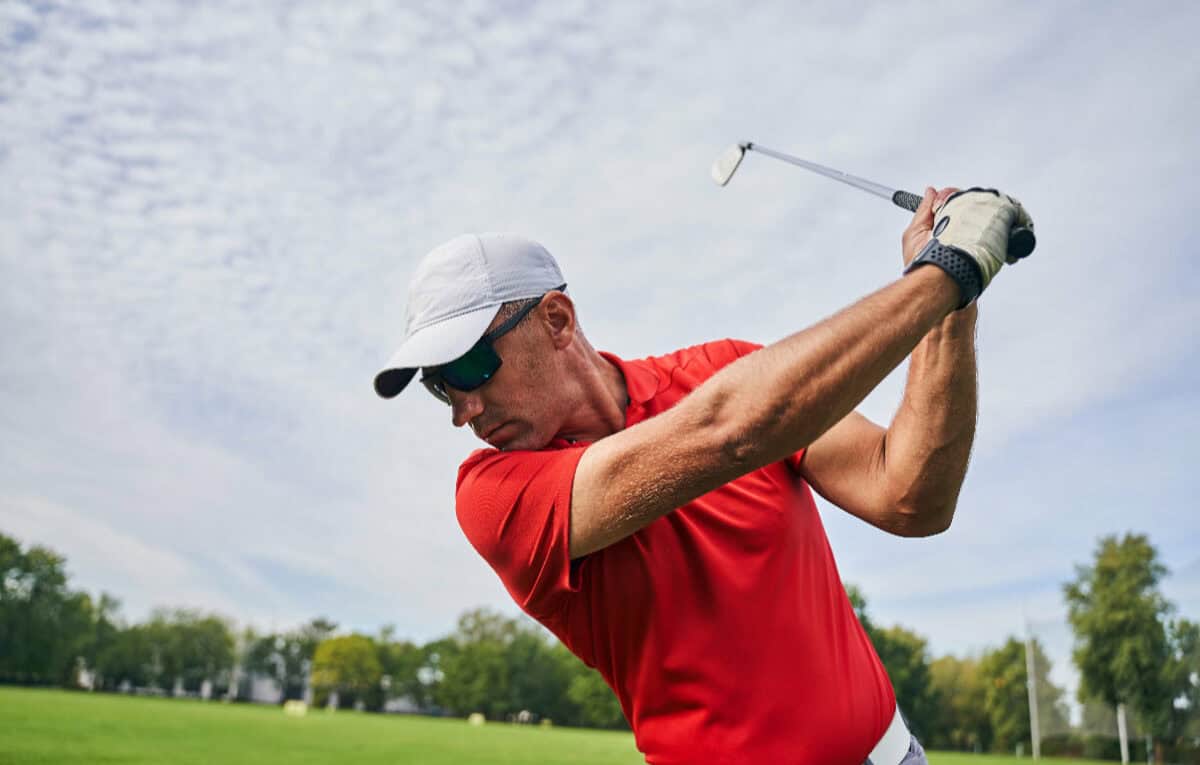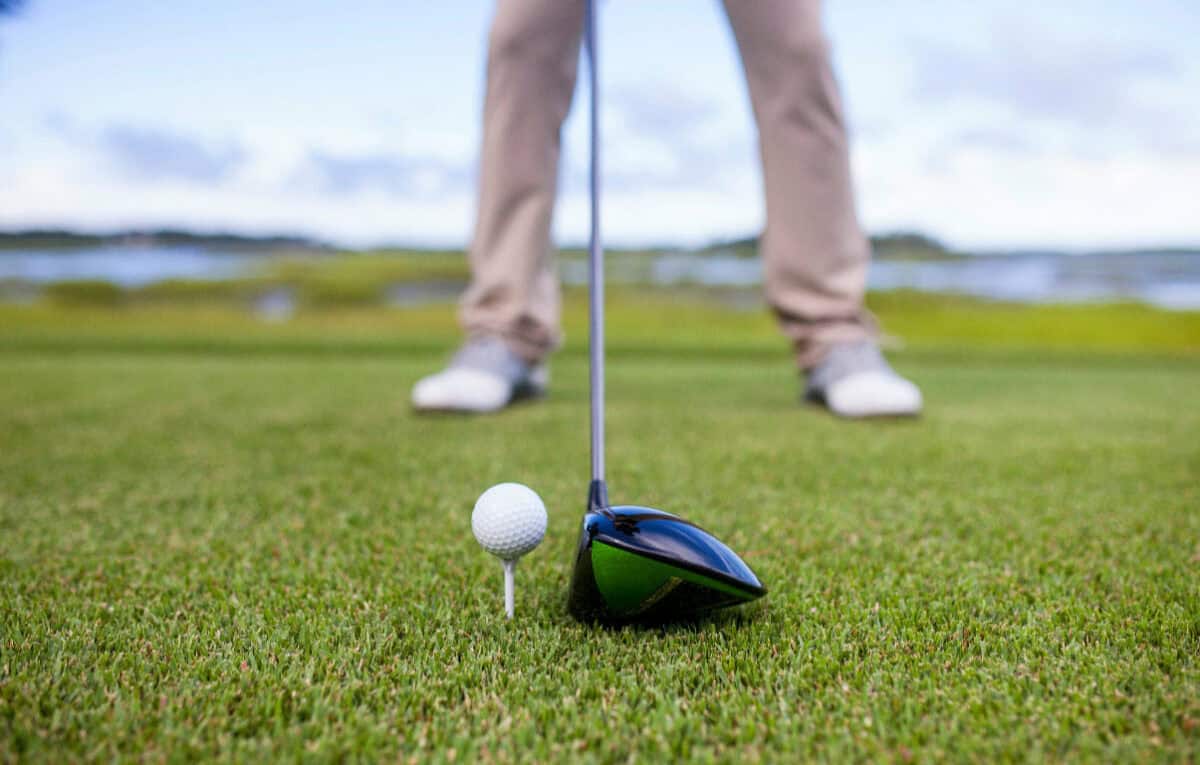How to Drive a Golf Ball Left-Handed?
For right-handed people, the mechanics of an effective left-handed golf swing can seem counterintuitive. But learning to drive a golf ball from the left side provides unique advantages.
Developing left-handed capability expands your shot-making versatility and ball-striking skills overall.
In this guide, I’ll offer step-by-step instructions on how to properly grip, set up, and swing to hit solid left-handed tee shots.
I’ll summarize alignment fundamentals, weight transfer, and swing plane principles adjusted from the standard right-handed technique. Let’s get started optimizing your left-side driving capability.

Advantages of Left-Handed Driving
While awkward initially, training yourself to confidently drive golf balls left-handed provides distinct benefits:
- Wider variety of recovery shot options from “trouble”
- Enhanced brain “left-right” hemispheric connections
- Improved hand-eye coordination and ball-striking rhythm
- Ability to monitor swing mechanics more objectively
Practicing left-handed shots expands your in-round shot creativity and trouble recovery.
Challenges of the Left-Handed Golf Swing
Despite advantages, left-handed golf also poses some inherent technique challenges:
- Weaker grip and forearm strength on lead left arm
- Unfamiliar “mirrored” alignments and swing motions
- Tendency to slice shot shape due to unfamiliarity
- Requires reps to gain clubface and path control
With persistence through early discomforts, left-handed swing basics become more repeatable.
Setting Up for the Left-Handed Golf Swing
To optimize the left-handed swing, use these basic address positioning fundamentals:
Foot Position – Align feet parallel left of the target line with the lead foot flared outwards.
Ball Position – Position the ball off the inside portion of the lead foot in a normal driving location.
Body Alignment – Square shoulders, hips, and feet to target line.
Hand Position – Lead left hand below right hand on the bottom of the grip.
Grip Pressure – Firmer pressure in the fingers of the lead hand to control the clubface.
Balance – Evenly distributed weight centered between feet.
These address adjustments establish an athletic left-handed posture over the ball.
Proper Left-Handed Golf Grip
Gripping the club left-handed requires the following key adjustments:
- Place lead left hand low on grip, turning clockwise into a stronger position.
- Ensure ‘V’ formed by the thumb and forefinger points toward the right shoulder.
- Place trail right hand on grip so thumb fits snugly into the lifeline of the lead hand.
- Use standard grip style – interlock, overlap, or baseball based on preference.
- Rotate both hands into a stronger position to compensate for the lead hand.
- Maintain light grip pressure to enhance hand-eye coordination.
Properly gripping the club left-handed prevents the lead wrist from rolling open at impact.

Importance of Ball Position and Stance
Consistent ball position and stance create a solid base for the swing’s rotary motion. Follow these left-handed recommendations:
Ball Position – Slightly forward of center aligned with left heel.
Stance Width – Slightly narrower than normal right-handed stance.
Foot Flare – Open lead foot outwards to allow fuller hip turn.
Ball Accuracy – Use foot spray or powder to monitor consistency.
Weight Distribution – Ensure balanced weight between feet with lead side slightly lower.
Repeating proper ball position and stance builds consistency into the left-handed swing.
Backswing Motion and Swing Plane
A compact, connected backswing sets the stage for solid ball-striking. Use these motions:
- Keep hands and arms synchronized to top of backswing.
- Maintain angle of the lead wrist; avoid cupping or rolling shut.
- Allow trail elbow to fold naturally; avoid over-extension.
- Rotate shoulders on spine angle aligned with the lower body.
- Shift weight slightly towards trail foot through backswing.
- Follow one-piece takeaway keeping clubface square.
Fluidly swinging the club to the top primes an efficient downswing.
Initiating the Downswing
To ingrain an accurate impact position, focus on these keys initiating the downswing:
- Transition weight back to lead side by dropping lead heel.
- Maintain lag and leverage; avoid casting or flipping hands.
- Keep trail elbow tucked in downswing; avoid disconnecting arms.
- Rotate through impact with hips clearing first.
- Release club naturally rather than consciously hitting at ball.
- Allow full release only once club approaches ball in downswing.
With balance and sequence, efficient energy transfer to the ball follows.

Striking the Golf Ball Solidly
The impact position itself determines solid ball-striking. Use these left-handed strike essentials:
- Hands lead clubface into impact, releasing at precisely the right moment.
- Strike ball before reaching lowest point in arc.
- Maintain spine tilt away from ball through impact.
- Generate speed with hips and legs; keep arms relaxed.
- Compress ball into turf to optimize energy transfer.
- Direct all force through the bottom center of the ball.
With efficient sequence, the left-handed strike compresses fully through the ball.
Completing the Follow-Through
A clean follow-through enhances rhythm while promoting desired shot shape and trajectory.
- Hold lag as long as possible then release fully through the ball.
- Maintain balanced athletic posture after impact.
- Allow arms to fully extend towards target.
- Rotate through impact with upper body and hips.
- Allow momentum to swing left arm vertically up and behind head.
- Finish in balanced pose holding trail leg extension.
The follow-through guides proper acceleration through impact.
Use Video and Mirrors to Monitor Positions
Because the swing motions feel awkward at first, video lessons and swing mirrors help ingrain ideal positions:
- Use mirrors to monitor grip, set up, and finish positions.
- Add video from face-on and down-the-line positions to compare motion.
- Play back swing videos frame-by-frame to diagnose problem areas.
- Lay alignment rods or golf shafts on the ground to train proper swing path.
- Draw lines on ball to ensure dynamic loft matches with face angle.
Video and training aids provide visible feedback improving left-handed technique.
Training aids to Improve Left-Handed Technique
Take advantage of training aids helping you groove correct left-handed release, path, and face angles:
- Impact bags – Groove releasing into the ball and preventing flipping.
- Alignment sticks – Guide proper takeaway, backswing and downswing path.
- Swing plane guides – Keep backswing and downswing on ideal Plane.
- Drawstring trainers – Ingrain correct release feel and hand path.
- Impact tape – Confirm centeredness of strike on clubface.
- Swing plane mirrors – Verify backswing plane from multiple angles.
Use training aids for immediate feedback critiquing your swing motions.
Importance of Left Hand Path and Wrist Action
Two final key swing elements requiring attention for left-handed driving are:
Lead Hand Path – Keep lead hand moving outwards with palm facing away from body through impact.
Lead Wrist Action – Maintain a firm lead wrist angle; avoid rolling over or dipping too early.
Controlling lead hand motions is vital for solid left-handed ball-striking.
Make Left-Handed Practice Enjoyable
Finally, some tips for making left-handed practice more engaging:
- Approach sessions with curiosity rather than frustration.
- Compete for accuracy rather than obsessing over swing mechanics.
- Focus on feel and rhythm instead of textbook positions.
- Monitor gradual progress week-to-week instead of expecting instant results.
- Practice left-handed shots from trouble or awkward lies to maximize creativity.
Staying positive, experimenting creatively, and tracking gradual gains keeps left-handed practice productive and fun.
With a growth mindset and focused work on fundamental adjustments, developing functional left-handed driving skills is within your reach.
Be patient through early awkwardness. In time, you’ll gain confidence hitting shots as effectively from the other side and unlock new recovery shot options. Embrace left-handed skills as a fun way to expand your golfing versatility.
